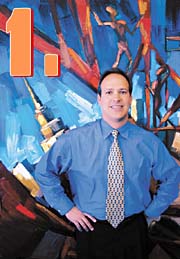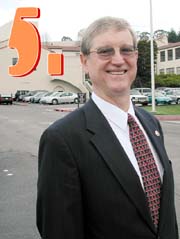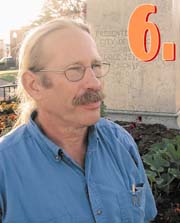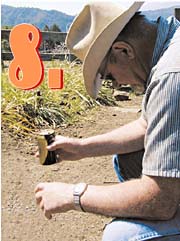|
 
IN
THE NEWS | GARDEN | ART BEAT | CALENDAR

by JOURNAL
STAFF
PAUL
GALLEGOS | TIMBER WARS | BUDGET CRISIS
HOUSING
PRICES CONTINUE TO SOAR
ROLLIN
RICHMOND REACHES OUT | DAVE MESERVE'S 15 MINUTES
CALPINE'S
LNG PROPOSAL | ROGER RODONI'S CONFLICT
MARIJUANA
CRIME | REDWOOD CURTAIN LIFTS?

Paul Gallegos
From the start, Paul Gallegos
has been making news. First, he defeated Terry Farmer for the
office of Humboldt County District Attorney in March 2002 --
shocking hordes of election-watchers who believed that the upstart
private defense attorney didn't have a prayer. (The Times-Standard
was so embarrassingly unprepared for a Gallegos victory that
they couldn't locate him on election night for comment.)
Gallegos hired as his assistant
Tim Stoen, who, opponents pointed out, was the No. 2 man (and
later whistleblower) to the infamous Jim Jones of the Peoples
Temple, the religious cult that committed mass suicide in the
Guyana jungle in 1978.
Then, within weeks of taking
office in January, the more liberal DA increased the number of
marijuana plants a medical patient could grow with a doctor's
OK to 99, as long as the plants' canopies fit into a 10-by-10-foot
area. Under Farmer, 10 plants was the limit.
Gallegos stepped into the spotlight
again in April when he injured himself surfing and had to be
rescued by the Coast Guard. Opponents were quick to question
why he was surfing on "county time," since the accident
happened on a Friday. Gallegos has countered that he puts in
far more than a 40-hour week.
But Gallegos' most controversial
move to date was the filing in late February of a fraud lawsuit
against Pacific Lumber Co. -- a move that sparked fury in the
timber industry and jubilation among environmentalists. (Attorneys
on both sides are still waiting for a ruling from Judge Christopher
Wilson on PL's July 28 motion to dismiss the case.)
Just two weeks after the suit
was filed, a rumor started that Robin Arkley Sr., flaming conservative
and former owner of Blue Lake Forest Products, was offering $5,000
to anyone who wanted to start a recall campaign against Gallegos.
Someone did. The campaign, which
drew supporters from law enforcement, including the Eureka Police
Officers Association and the Humboldt Deputy Sheriffs Organization,
began collecting signatures in May. Gallegos' supporters pointed
out that the signature-gathering was not exactly done by the
book, with petitions left out in the open at stores like Hoby's
Market in Scotia and the V&N Burger Bar in Arcata, and 11th-hour
petitioners paid $8 per signature to come in to Humboldt County,
presumably register to vote here, as the law requires, then collect
the lucrative John Hancocks.
At one point, observers wondered
if the campaign was going to peter out. But -- thanks in part
to a $40,000 contribution to the recall effort by Pacific Lumber
-- organizers managed to submit some 16,000 signatures to the
county elections office, meeting the requirement of approximately
11,000 verified signatures, by the October deadline.
Now, Gallegos, 42, is preparing
to fight for his job: Three attorneys have come forward to campaign
for DA in the recall election, set for March 2. The first to
announce was Steve Schectman, 51, a private civil attorney who
has had his own celebrated bouts with Pacific Lumber. (He represented
the mother of David "Gypsy" Chain, a forest activist
who was killed by a felled tree during a 1998 protest, in a negligence
case against the company that resulted in a monetary settlement.)
Schectman said he was throwing his hat in the ring to carry on
Gallegos' policies in case the recall is successful. Also running
is longtime prosecutor Worth Dikeman, 58, who has 18 years experience
in the DA's office and is one of its most respected prosecutors.
Calling himself a "very reluctant candidate," Dikeman
said he too supported Gallegos and wanted to join the race to
make sure there was an experienced prosecutor to run the office
if Gallegos is booted out.
The third candidate is the only
one actively campaigning against Gallegos: Gloria Albin Sheets,
58, who worked for eight years under Terry Farmer and a brief
period under Gallegos. (She says she was dismissed; the county
says her position was eliminated due to the loss of a grant.)
Albin Sheets has echoed many of the stated concerns of the recall
supporters -- alleging that Gallegos is soft on crime, for instance
-- and she is the only candidate to say she will reevaluate the
DA's lawsuit against Pacific Lumber.
Through it all, Gallegos has
maintained a calm, professional demeanor, saying he will continue
to concentrate on his job. His supporters seem energized by the
task at hand, and the DA has become something of a cause celebre
among progressives. (One recent fund-raising event was said to
have been attended by "every liberal in Humboldt County.")
We don't doubt that Gallegos, the recall and the suit against
PL will be among next year's top stories, too.
-- Emily Gurnon

Timber Wars
Maybe it was Paul Gallegos'
fraud lawsuit against Pacific Lumber. Or perhaps it was the increasing
polarization between the local timber industry and its opponents.
Whatever it was, 2003 saw a large number of developments on the
logging front -- both in the woods and the courts.
Gallegos' lawsuit got the ball
rolling. Filed in February, it accused the company of concealing
critical information during the 1999 Headwaters negotiations.
The alleged deception enabled the company to log as many as 100,000
redwoods on unstable slopes that it otherwise wouldn't have been
able to get at. The DA's office announced that it was seeking
as much as $250 million in damages.
Then came what might be called
the battle of Freshwater. Activists had taken to the trees big
time in the steep area right off Greenwood Heights Road, arranging
themselves into an "Upper Village" and a "Lower
Village." The location seemed ideal for the protestors:
It was easy to access, for one thing, and because of that, the
prospect of frequent media coverage seemed likely.
The press certainly paid attention,
but whereas a few years ago Pacific Lumber loggers might have
only been able to toss rocks at the tree-sitters, now the company
had a new weapon: tree climbers. Methodically, and to hear the
tree-sitters tell it, in some cases violently, activists were
taken down from the trees beginning March 17 and arrested. It
took some doing, but eventually the "villages" were
all cut down -- save for a single redwood named "Jerry,"
after the Grateful Dead's Jerry Garcia, which had been occupied
for nearly a year by Julia Butterfly Hill's heir apparent, Remedy,
aka Jeny Card.
In May, the Garberville-based
Environmental Protection Information Center seemed to score a
major victory when Judge John Golden invalidated a pillar of
the 1999 Headwaters deal, the Sustained Yield Plan. Intended
to govern harvest rates over the next 100 years, the plan was
deemed invalid because no such document exists -- at least not
in a form usable by regulators or members of the public.
Activists read the order as
requiring an immediate halt to logging on PL's land. There was
even some talk that if the SYP is invalid, then so are all the
logging permits that have been issued under its auspices. In
other words, all the logging that has been carried out on PL
lands since the signing of the Headwaters deal in the spring
of 1999 has been illegal.
In the end, though, the ruling
had little practical effect. Citing concerns about undue economic
harm to the company, Golden did not shut down any logging. His
ruling may still be useful to activists as precedent in future
litigation, but otherwise it was a hollow victory.
Timber news in the fall was
dominated by a demand from more than 60 residents that Pacific
Lumber be made to dredge the Elk River, which floods at the drop
of a hat due to excess sediment deposition from surrounding timberlands
(see "Last Resort," Oct. 16); and by the contents of
an Oct. 24 letter to PL employees from CEO Robert Manne, in which
he blasted residents of Elk River and the adjacent Freshwater
basin for "extorting" money from the company.
 --
Keith Easthouse --
Keith Easthouse
Budget crisis
The distant rumblings of a coming
catastrophe were first heard in January. By December, local government
was up to its neck in the worst budget crisis in memory.
Early in the year, before the
2003-04 budget was to be finalized, most local governments took
preventative measures. The county instituted a hiring freeze,
leaving unfilled positions vacant. Then, around mid-year, the
numbers came in -- and they were worse, even, than most had feared.
Certain county services suffered
especially. The Sheriff's Office, which many would consider the
county's most important, front-line service, got a triple hit.
The first was due to general county downsizing, when all departments
were asked to make 15 percent reductions in their budgets. Then
came the loss of a $500,000 state grant for rural law enforcement.
Finally, there was the near-total loss of receipts from the state's
Vehicle License Fee program, which Gov. Arnold Schwarzenegger
gutted immediately upon taking office. In total, the office has
had to cut $1.7 million from its budget.
"We've cut back everywhere
in the department we can," said Sheriff Gary Philp. "We've
got nowhere else to go, except salaries."
County government was far from
the only local agency to feel the pain. Cities, schools and special
districts also slashed personnel and services. In June, at a
contentious and painful meeting of the Board of Supervisors,
fire chiefs from around the county showed up to beg for funding
from the county, which itself had all too little to give.
Assistant County Administrative
Officer Karen Suiker said that none of the financial crises she's
seen -- she's been with the county more than 20 years -- compare
to what local governments have gone through in recent months.
"This has been the most
challenging budget year. I think next year is going to be even
more challenging. But I think this county is going to rise up
and meet the challenge." She did acknowledge, though, that
it's going to take more than can-do spirit to solve the problems
the county finds itself in. At some point, money will have to
be found -- or more fires will burn unchecked, more criminals
will go unpunished and more people will go hungry.
 --
Hank Sims --
Hank Sims
Housing prices continue to soar
Once touted by a local agent
as "the last affordable coastal real estate in California,"
Humboldt County seems determined to shed that reputation. The
affordability of housing in the county hit an all-time low in
October, according to the Humboldt Association of Realtors, with
the median sales price of a single family home peaking at an
astounding $222,000. That's a price that only 26 percent of county
residents can afford, the association calculates.
The rise in home prices over
the last two years or so is "unprecedented for this area,"
said Bruce Rupp, president of the Realtors' group. "Individuals,
particularly young families trying to buy a home, are having
a very difficult time. Even with those low-interest, no-money-down
loans, people are just not able to buy in."
And rental rates have been rising,
too, putting the squeeze on working families. "It's pretty
hard to pay $600 or $700 a month for an apartment when you're
making $10 an hour," Rupp said.
Those who already own property
may be happily watching their equity soar, but for would-be homeowners,
"it signals trouble," said HSU economist Erick Eschker,
director of the university's monthly Index of Economic Activity.
That's especially true given the fact that county unemployment
rose slightly in October, from 5.1 to 5.3 percent.
The solution? Increase the supply
of housing, Rupp said.
"We are going to have to
find ways to provide additional housing and thereby lower the
cost of housing for people," he said.
Driven at least in part by migration
of equity-rich homebuyers from places like the San Francisco
Bay Area and Southern California, the rising cost of housing
has ominous ripple effects. One of those is the plummeting enrollment
in Humboldt County schools -- the number of students dropped
6.5 percent between 2001-02 and 2002-03 -- which in turn means
less money for local districts.
"The biggest threat to
us is affordability of housing," said Steve Kelish, superintendent
of the Arcata Elementary School District, earlier this year.
"We're just not getting the kids moving in here because
their families cannot afford to live here."
Next boomtown -- Crescent City?
 --
Emily Gurnon --
Emily Gurnon
Rollin reaches out
Humboldt State University's
new president started his job in July of 2002, and this year,
Rollin Richmond has established himself as a dynamic leader whose
ideas and openness have brought new energy to the campus -- and
the larger community -- despite the dire budget outlook.
"I don't want anything
I say to be a putdown of [former president] Alistair [McCrone],
but I believe Rollin Richmond is a much more inclusive leader,"
said Arcata Mayor Bob Ornelas. "And he's made a great first
impression."
Richmond has mended fences with
the outside community on a number of fronts, not least of which
is plans for the new Behavioral and Social Sciences building
-- which had brought the university to a nasty standoff with
the city of Arcata. Richmond made an effort to reopen the lines
of communication with the building's opponents, and the university
eventually made some changes in the building's design and location.
"The relations between
HSU and the community, I haven't seen them this good in 20 years,"
Ornelas said. "I feel like for the first time we're at the
same table and on the same page as HSU."
Supervisor John Woolley said
Richmond took the initiative to get to know people in the community.
"It's a different style, I think. He's been a dynamo. His
energy is quite remarkable and I think he's gotten to know our
community quite well."
He's made an impression on campus,
as well, scoring points for his willingness to communicate bad
news as well as good.
"His whole management approach
is very different from the previous administration: more inclusive,
much more open. Decisions are made with all of the players involved
and all the input is really making a big difference," said
Dr. Luke George, professor of wildlife management and this year's
HSU Scholar of the Year. "I truly think he's energized the
campus.
"Unfortunately, he landed
at a time when cutbacks are so severe," George continued.
"In some ways it does make for opportunities, and I think
having him there is going to be a very positive force even in
these hard times."
 --
Emily Gurnon --
Emily Gurnon
Dave Meserve's 15 minutes
To understand what kind of year
Dave Meserve has had, you need only know this: He got more media
attention than Paul Gallegos.
Not locally, perhaps. But nationally
and internationally, the pony-tailed, 50-something hippie with
the broom mustache and goofy grin was Humboldt's biggest star.
How big? Well, the Green Party
member was prominently featured in a front-page article in the
Washington Post, appeared on broadcasts by Fox News and
CNN, and made newspapers in Europe. He was even interviewed by
Al-Jazeera, the Arab satellite television network.
Meserve's drive to fame started
back in January when, after only a few weeks on the job, he persuaded
his fellow council members to approve a resolution condemning
the USA Patriot Act, which gives law enforcement sweeping powers
to conduct terrorism investigations. Then in April the council,
at Meserve's behest, went a step further and passed an ordinance
requiring city department heads to refer potentially unconstitutional
federal requests made under the law to the City Council for review
-- particularly requests that might violate someone's civil rights.
In other words, Arcata made it illegal to comply with the act.
Since no other community in
the country had done that, the press took notice. One of the
first things reporters wanted to know was who was behind this,
and so Meserve found himself in the spotlight.
Despite his strong political
views, Meserve is an unassuming fellow -- but that didn't stop
him from doing a little exulting. "I campaigned on the platform
that the federal government is stark raving mad and I'm glad
they put that on the front page of the Washington Post,"
Meserve told the Journal when the media frenzy was at
its height.
Figuring he was on a roll, Meserve
started pushing next for a resolution demanding President Bush's
impeachment -- on the grounds that he had launched an unprovoked
attack against Iraq and had lied to Congress and the American
people to gain support for the invasion. (See "Man on a
mission," Sept. 18.)
His fellow council members didn't
hand Meserve what he wanted this time around -- given political
realities, it was recognized that there was no way Bush could
be impeached before next year's presidential election. By October,
a compromise was struck: The council sent a letter to Congress
asking for an investigation into whether President Bush and Vice
President Dick Cheney committed impeachable offenses in the buildup
to the Iraq war. Meserve, who was scheduled to go to Washington,
D.C., to take part in a conference on the USA Patriot Act, hand-delivered
the letter to the House Judiciary Committee.
 --
Keith Easthouse --
Keith Easthouse
Calpine's LNG proposal
When it emerged in the summer
that a San Jose energy company called Calpine was talking with
local business and political leaders about the possibility of
constructing an LNG, short for liquefied natural gas, import
terminal on the Samoa Peninsula, one thing seemed clear: Here
was a new acronym.
Like so many first impressions,
that one turned out to be untrue. LNG was an old controversy.
It also became clear that LNG wasn't some new, exotic substance.
It was just the same blue gas many of us cook with and heat our
homes with every day.
What's different about LNG is
that it's been made so cold -- on the order of 260 degrees below
zero -- that it has condensed into a liquid. Why convert it?
Because in its liquid form it takes up 600 times less space than
it does when it's a gas. Chilling it, in other words, makes it
possible to transport vast amounts of natural gas at an affordable
cost. The downside is that concentrating natural gas in this
way greatly increases its danger. It makes possible the ignition
of an enormous amount of gas in one place.
The unusual fire hazard posed
by LNG was made clear way back in 1944, when 2 million gallons
of the stuff escaped from a defective storage tank and spilled
into the streets, and ultimately the sewer system, in Cleveland.
A ferocious fire ensued that killed 128 people.
60 Minutes examined the public safety hazard posed by LNG
in a broadcast in the late `70s. The news hook was that LNG projects
were popping up all over the place due to rising demand for natural
gas.
That's also the case today,
which is the fundamental reason behind the Calpine project.
Like the proposal by an Alaska
businessman to haul millions of gallons of water from the Mad
River to points south in giant bags, the proposal floated by
Calpine is nothing if not ambitious.
Nine hundred foot long tankers,
the largest ships ever to enter Humboldt Bay, would come in at
the rate of two per week. Their hazardous cargo, 33 million gallons
worth per ship, would be pumped into storage tanks -- probably
two in number -- standing 150 feet tall and 250 feet across.
A "regasification" plant would warm the fuel, back
into its normal vapor form. The gas would then be sent via a
new, 36-inch pipeline under Humboldt Bay and out to Red Bluff,
a distance of 155 miles, where it would feed into the Central
Valley's energy grid. It would also power a new 220-megawatt
power plant that would replace the aging PG&E facility that
the Humboldt Bay region still depends on. The entire construction
project, which would include building a new dock, would likely
take three years and cost $750 million.
This is more than talk as Calpine
has sunk hundreds of thousands of dollars on preliminary studies.
Company officials shrugged off a decision by the Eureka City
Council earlier this month to deny Calpine access to the Eureka
Municipal Airport in exchange for doing a feasibility study.
The advantage to that location is that it is closer to the harbor
entrance and farther from populated areas. Another possible site
is the 80-acre, defunct Simpson pulp mill property; the difficulty
there, however, is that should an LNG fire break out, Bayshore
Mall, among other places, could be at risk. (See "Destination
Humboldt Bay?" Nov. 6.)
 --
Keith Easthouse --
Keith Easthouse
Roger Rodoni's conflict
It was never a secret, exactly
-- people had been talking about the fact that 2nd District Supervisor
Roger Rodoni held a lease on a substantial portion of Pacific
Lumber land since he first ran for the office in 1992. Rodoni
had been living and raising cattle on the land, called the Rainbow
Ranch, since 1969.
But Rodoni's arrangement with
PL moved to center stage earlier this year, after he joined three
other supervisors in denying DA Paul Gallegos' request to the
board for outside legal help in his suit against the company.
Critics said that Rodoni should have recused himself from the
vote -- that his lease of the land amounted to a conflict of
interest when voting on PL-related matters.
The conflict of interest seemed
even more glaring when details of the lease hit local papers
in June. The land in question amounted to around 9,000 acres,
including a house and a barn, and for it Rodoni paid only $4,200
per year -- or $350 per month.
Despite the ensuing outcry,
Rodoni maintained that the amount he pays for the ranch is fair.
He said that only about one-third of the land is suitable for
cattle grazing -- his primary use of the land. He noted that
by the terms of the lease, he is responsible for maintaining
the property's structures and roads. And he chided his critics
as city folk who don't understand the demands of rural living.
Nevertheless, the issue continues
to strike a chord. As recently as last week, a citizen addressing
the Board of Supervisors again chastised Rodoni for voting on
the question of outside counsel. With Rodoni up for re-election
in March, the supervisor is sure to be hearing more such criticism
in coming months.
Meantime, the Fair Political
Practices Commission, the state agency charged with policing
conflict-of-interest laws, has opened a file on the case -- meaning
that sooner or later its investigators will probably be asking
questions of him.
-- Hank Sims

Marijuana crime
   it
the beginning of a trend, or was it just a very bad year? Whatever
the case, the startling amount of violence related to the marijuana
trade this year has everyone -- from dealers to cops to everyday
citizens -- on edge.
"It seems to be in most
cases that the violence involves deals or transactions made with
people from out of the area," says Sheriff Gary Philp. "And
it appears that the clientele are people that they ought not
to be dealing with."
On Aug. 11, Southern Humboldt
residents Chris Giauque and Rex Shinn were both reported missing
to the Sheriff's Office -- neither has been found, and both are
believed dead. Giauque, a prominent medical marijuana advocate,
had been on a trip to the Spy Rock Road area of Mendocino County
-- the precise purpose of the trip was unknown, but was presumed
to have involved drugs. Shinn was believed to have been murdered
in a drug deal gone bad. The incidents were probably unrelated.
Two weeks later, Whitethorn
teenager Sean Akselsen was shot dead near Briceland. Three unidentified
African American males from the Bay Area or Sacramento are suspected
in the murder -- they had apparently been staying in the Garberville
area for a few days, looking to score, before they met Akselsen.
Those were the worst incidents
this year, but far from the only ones. There were two home invasion
robberies connected with the drug, in Arcata and Manila. A carjacking
and attempted murder in the Dyerville area was rumored to be
related to a marijuana deal. There was a murder and car chase
just over the Humboldt County line near Willow Creek in November
-- a deal gone bad.
The robbers' greed is the principal
cause of the violence, of course -- but the deplorable self-interest
of some locals involved in the industry helps insure that this
unacceptable situation becomes ever more common.
"We have a lot of people
who are reticent to come forward because they're afraid they'll
get in trouble," Philp says. "We certainly try to tell
them that there's no more serious crime than the taking of human
life."
-- Hank Sims
 Redwood
curtain lifts? Redwood
curtain lifts?
For two years, the county was
held hostage in a fight between Caltrans and SBC Communications
over the details of a deal to finish a fiber-optic line that
would modernize the region's communications infrastructure. Then,
in June, the two behemoths of government and industry reached
agreement, and the work was completed in a few weeks.
Local business leaders rejoiced,
briefly. Then they and local elected officials turned back, with
renewed vigor, to the more difficult problem of moving people
and goods -- rather than bits and bytes -- in and out of the
county. The year was notable both for their efforts, which seemed
to shoot off in every direction at once, and for the combined
forces of geology and bureaucracy that seemed set against them
at every turn.
Throughout last winter, conditions
on local highways were worse than usual. Highway 101, the county's
main artery, was closed both north and south several times --
most notably at Confusion Hill, near the Mendocino County border.
That experience led to an ambitious plan to reroute the troubled
section of road to the other side of the canyon, but a tight
funding deadline meant that numerous and complicated permits
and environmental reviews would have to be completed in record
time. All of that is still in the works.
Supervisor Bonnie Neely led
an effort to secure funds for the rebuilding of Highway 299's
Buckhorn Summit, which would allow U.S. standard-sized cargo
trucks to enter the county for the first time. The massively
expensive project would require large infusions of federal dollars.
When Sen. Barbara Boxer made a swing through town, she promised
to help -- but the county gave itself $50,000 in Headwaters Grants
to hire a lobbyist for the issue, just in case.
The North Coast Railroad Authority
gave up, for the time being, the effort to restore train service
to the county. The better part of a $41 million state grant it
had been awarded a few years ago evaporated, and the authority
could not even attempt to breach the storm-wrecked Eel River
Canyon section of the line without that money.
Officials from the Port of Humboldt
Bay began talks with the Port of Oakland about a partnership
under which container truck traffic could be diverted here from
the gridlocked Bay Area.
And a $10 million plan to extend
the runways at the Eureka-Arcata airport in McKinlyeville was
announced in the fall -- the county's planning department said
the change was necessary to accommodate more and larger planes,
but neighbors began to organize in protest.
-- Hank Sims
IN
THE NEWS | GARDEN | ART BEAT | CALENDAR
Comments?

© Copyright 2003, North Coast Journal,
Inc.
|